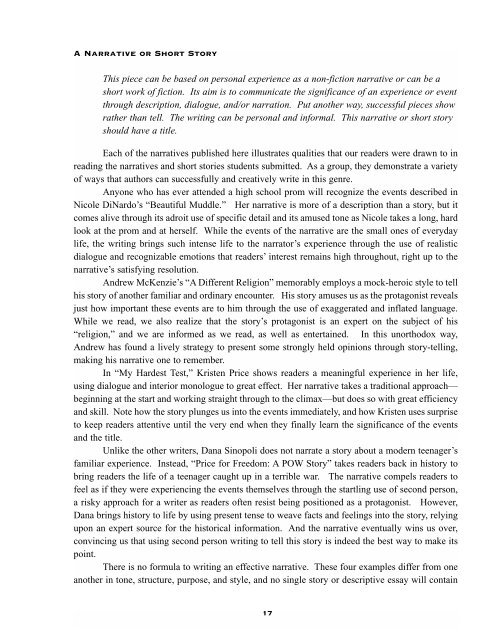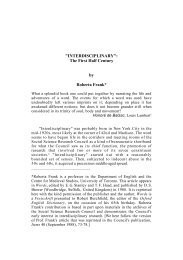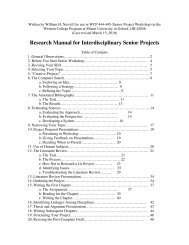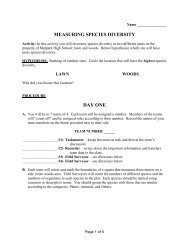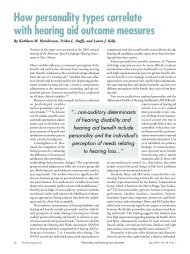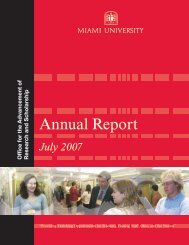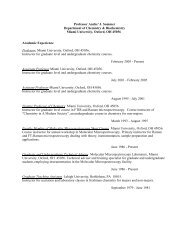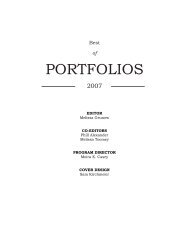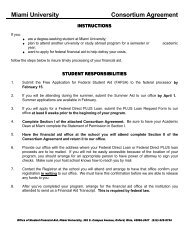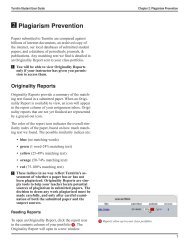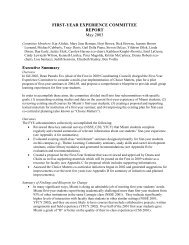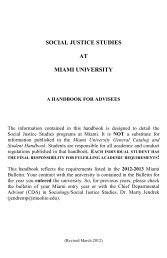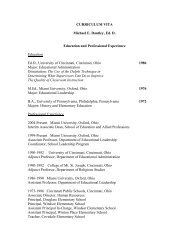Best of Miami Portfolios 2001 - Units.muohio.edu
Best of Miami Portfolios 2001 - Units.muohio.edu
Best of Miami Portfolios 2001 - Units.muohio.edu
You also want an ePaper? Increase the reach of your titles
YUMPU automatically turns print PDFs into web optimized ePapers that Google loves.
A Narrative or Short Story<br />
This piece can be based on personal experience as a non-fiction narrative or can be a<br />
short work <strong>of</strong> fiction. Its aim is to communicate the significance <strong>of</strong> an experience or event<br />
through description, dialogue, and/or narration. Put another way, successful pieces show<br />
rather than tell. The writing can be personal and informal. This narrative or short story<br />
should have a title.<br />
Each <strong>of</strong> the narratives published here illustrates qualities that our readers were drawn to in<br />
reading the narratives and short stories students submitted. As a group, they demonstrate a variety<br />
<strong>of</strong> ways that authors can successfully and creatively write in this genre.<br />
Anyone who has ever attended a high school prom will recognize the events described in<br />
Nicole DiNardo’s “Beautiful Muddle.” Her narrative is more <strong>of</strong> a description than a story, but it<br />
comes alive through its adroit use <strong>of</strong> specific detail and its amused tone as Nicole takes a long, hard<br />
look at the prom and at herself. While the events <strong>of</strong> the narrative are the small ones <strong>of</strong> everyday<br />
life, the writing brings such intense life to the narrator’s experience through the use <strong>of</strong> realistic<br />
dialogue and recognizable emotions that readers’ interest remains high throughout, right up to the<br />
narrative’s satisfying resolution.<br />
Andrew McKenzie’s “A Different Religion” memorably employs a mock-heroic style to tell<br />
his story <strong>of</strong> another familiar and ordinary encounter. His story amuses us as the protagonist reveals<br />
just how important these events are to him through the use <strong>of</strong> exaggerated and inflated language.<br />
While we read, we also realize that the story’s protagonist is an expert on the subject <strong>of</strong> his<br />
“religion,” and we are informed as we read, as well as entertained. In this unorthodox way,<br />
Andrew has found a lively strategy to present some strongly held opinions through story-telling,<br />
making his narrative one to remember.<br />
In “My Hardest Test,” Kristen Price shows readers a meaningful experience in her life,<br />
using dialogue and interior monologue to great effect. Her narrative takes a traditional approach—<br />
beginning at the start and working straight through to the climax—but does so with great efficiency<br />
and skill. Note how the story plunges us into the events immediately, and how Kristen uses surprise<br />
to keep readers attentive until the very end when they finally learn the significance <strong>of</strong> the events<br />
and the title.<br />
Unlike the other writers, Dana Sinopoli does not narrate a story about a modern teenager’s<br />
familiar experience. Instead, “Price for Freedom: A POW Story” takes readers back in history to<br />
bring readers the life <strong>of</strong> a teenager caught up in a terrible war. The narrative compels readers to<br />
feel as if they were experiencing the events themselves through the startling use <strong>of</strong> second person,<br />
a risky approach for a writer as readers <strong>of</strong>ten resist being positioned as a protagonist. However,<br />
Dana brings history to life by using present tense to weave facts and feelings into the story, relying<br />
upon an expert source for the historical information. And the narrative eventually wins us over,<br />
convincing us that using second person writing to tell this story is indeed the best way to make its<br />
point.<br />
There is no formula to writing an effective narrative. These four examples differ from one<br />
another in tone, structure, purpose, and style, and no single story or descriptive essay will contain<br />
17


